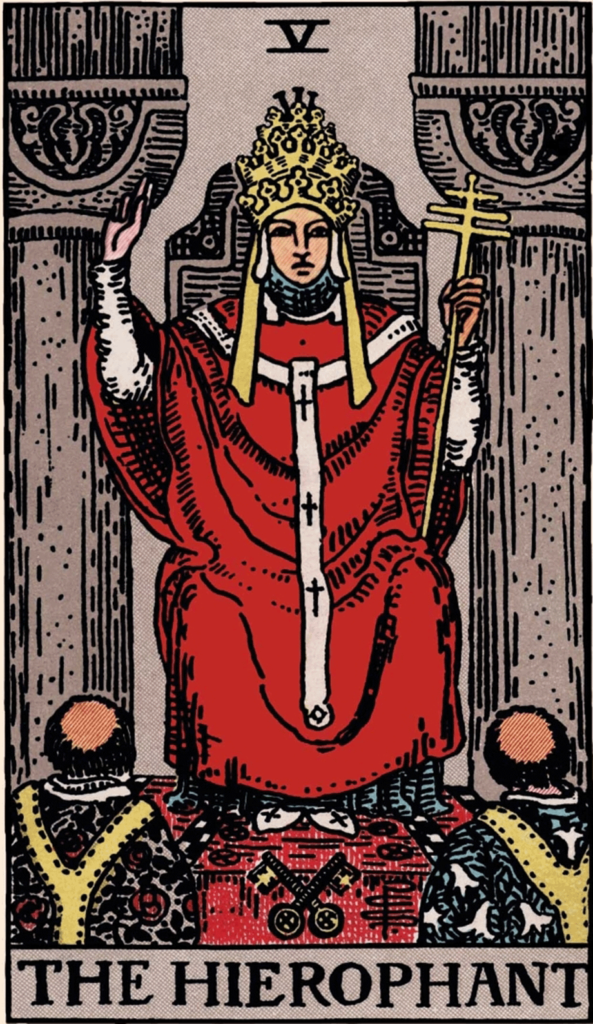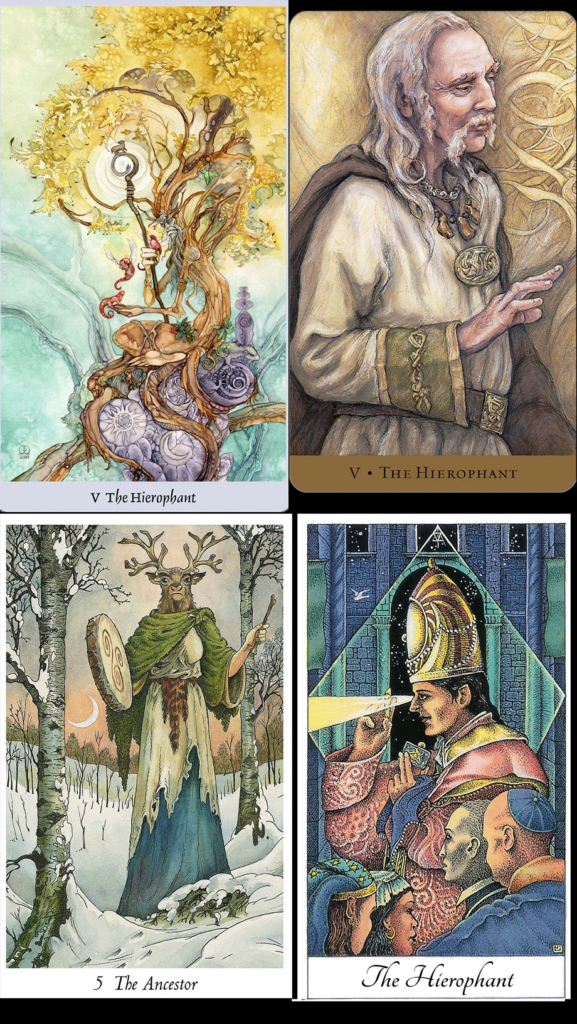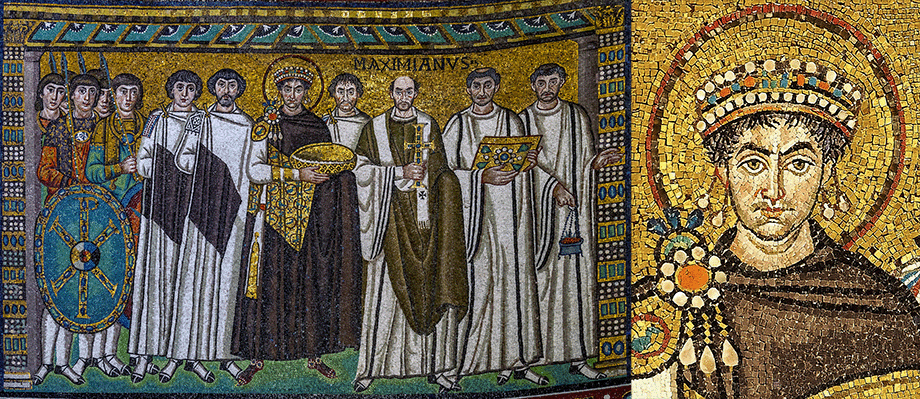The sixth card which is numbered V, has one of the most overtly Christian iconographies in a set of cards that has a lot of them. This card was originally the Pope. It is named that in European decks that precede the RWS, and despite Waite’s changing the name to a more exotic Greek one, the design preserves both the traditional image, and amplifies it in that same Gothic Medieval style. The Hierophant may just as well be taken from a stained glass window in a cathedral, as it offers us little in the visual sense to merit divorcing it from its original Catholic nominative.
That image is one of the King of the Church, with his three crowns, on his throne, in full raiment, holding a triple cross in his left hand and making the sign of blessing with his right. The high-back throne is situated between two Norman style pillars on a raised dais, covered with an embroidered red carpet. Affixed to the front of the dais are a pair of crossed keys, traditional part of the Papal arms. To either side are tonsured supplicants. The one on the left wears a robe decorated with roses, the other with lilies. The dominant color on this card is grey, forming the background, the throne, and the columns. The priest of the rose has a grey robe, the one of the lily is a grey blue. Both priest have yellow vestments. The Hierophant himself is draped in red with white trim, and the bottom of his robe is blue. These are traditional colors associated with Christian depictions of Christ and the Virgin in Renaissance art.

When I got my Hoi Polloi Tarot in the early 1970s, I admit to feeling cheated that what I expected were going to be “occult” cards had such obvious Christian images, and this one was perhaps the most “offensive” to my young sensibilities. I was not, at this point, educated on the entanglement between magic and occult practices and the traditions of the Abrahamic religions. Now, of course, we should all be at least acquainted with the influence that monotheistic orthodoxy has had on so-called “pagan belief”.
We live in an age where the perceived taint of Judaism, Christianity, and Islam is very hard to remove from our ritual and belief. Reconstruction of pagan or pre-Christian belief in the late 19th and early 20th century was hardly scientifically approached. The Victorian magic lodges were actively calling on angels and powers in the secret name of the old Hebrew sky god, and that with many of the liturgies and rituals of the Church. “Folk” pagan movements borrowed from stories that had clearly been altered by centuries of enforced Catholicism, and synthesized based on rejecting or inverting the Christian teachings.
I personally think that much of that early monotheism itself has been redacted and retro-actively continued to match more modern perspectives, as well. Certainly Judaism offers us Kabbalah and a rich magical tradition in parallel with the sacred and practical teachings of the Torah and Talmud. First century Christianity contains more things that were deemed heretical, blasphemous, and even satanic than what eventually made it into the dogma, and early Islam has a similar history of dissent, disagreement, and disinformation.
The result is that what has passed down to us today is not clear, not original, and not perhaps accurate. When we step on the path of working with the secrets of the universe, we should be aware that some of those secrets are just plain lies.
The word Hierophant per the dictionary is most generally rendered “priest of the mysteries of the religion”. He is the arbiter between the mundane world that all may observe, experience and understand, and the world of sacred and divine that only the initiated may experience. He echoes both the Priestess and The Emperor in his pose and his situation.
Whereas the Priestess offers us the means to bridge the ideation of opposites, and the Emperor forces us to encounter the “I”, the Hierophant provides specific methods of instruction. These are the keys at his feet.
In the Christian iconography, and the Papal arms, these keys are the ones given by Christ to Simon Peter that open the gates of the Kingdom of Heaven. Peter is probably not actually his name, but derives from the Greek “petra” or stone. Peter is the disciple, who despite several issues detailed in the gospels, Jesus calls the “Rock on which I will build my church”. As Peter is officially the first Pope, this description is rather fortuitous.
The keys were conferred to Peter in the same passage (Matthew 16:17 if you’re interested) along with the curious authority of being able to cause things that he bound upon the earth to be bound in heaven and that he loosed upon the earth to be loosed in heaven.

The Shadowscapes Tarot -Stephanie Law’s lyrical watercolor work presents a being related to Treebeard himself, and more at harmony with the mysteries of the natural world than a cultist in a cathedral.
The Tarot of the Hidden Realm – This deck is very Celtic/Faerie oriented and the illustration here by artist Julia Jeffrey of a personable druid is certainly more approachable.
On a different tack, Norbert Losche’s Cosmic Tarot combines what at first appear to be traditional religions with symbolism from occult and Oriental sources to hint that perhaps what is behind the temple doors is bigger than any one path.
Finally the WildWood Tarot shows us something called The Ancestor. This very Celtic/Shamanic deck presents a number of the traditional cards under new names and vastly alters their interpretation. In the shamanism of the Celts, the spirits of the ancestors have the authority to pass us through the mysteries. The artist is Will Worthington.
This sounds very much like the “As Above, So Below” of the Emerald Tablet of Hermes the Thrice Great, which may have been well known to the Greeks and Romans at the time the Book of Matthew was being compiled, possibly around 60-70 years after the events they were describing. Now that, of course, is the earliest version, and as noted above, many edits may have been made between then and later doctrines. These early Greek texts are supposedly the original source material, but given the history of religious thought that we have from modern times, it’s impossible to say with certainty that they represent an actual historical account, and have not, themselves, been “corrected” even at that early stage.
The Hermetic documents end up in Western European circles by way of Islam. These were perhaps preserved among other documents from the Library of Alexandria because they were not directly heretical to Islam whereas Christian authorities might have destroyed or suppressed them. While most public schools teach of the burning of that library by the Romans during Caesar’s time in Egypt, fewer mention that succeeding intentional purges were committed by both Christians and Moslems in later periods that resulted in many things being lost to humanity forever. Yet copies that had been made by Jews and Moslems at earlier times survived, and re-emerged as the vice grip of the Catholic church started slipping in the 15th century.
So perhaps the secrets being kept by the Hierophant are not those the Papacy and the mysteries of the Church, but of a secret Hermetic magical tradition. Perhaps Peter’s keys were an esoteric expression of the elevation of all humanity through the transformations of the Philosopher’s Stone and the Elixir of Life. The powers ascribed to these long-sought solutions are eternal health, eternal youth, and eternal life, not so far from the immortality promised in the kingdom of Heaven. Whether or not Medieval alchemy was a confusion from a Papal esotericism, or if it was the other way around, is hard to tell, but it is one way we can break ourselves from of that initial reaction that we are looking at a Catholic pontiff.
We can also disconnect the red robe from the Holy Blood and recast it as the Elixir of Life. The blue of the robes beneath the Hierophant’s mantle can connect us to the Water Element, and the distillation or “liquefaction” of the process where the elements dissolve into “water” before reforming into the Philosopher’s Stone. We can assign the tripartite crown and triple cross to Hermes Trismegestus – The Thrice Great, and the entire scene magically dissolves into a pre-Christian pagan symbol for the pursuit of the Alchemical Ideal, the Great Hidden Secret of The Universe
As Above, So Below.
This ties well into my own perspective on the first six cards of the Major Arcana, and their interrelationship. The Hierophant sits at the bottom point of the “Below” triangle. He is that reflection and manifestation of the wild naked formlessness of the Fool. The Fool is the Universe as it is, as it is Becoming. The Hierophant is the Universe as it must be masked, to prevent us from being dissolved back into it. The secrets kept are wonderful and terrible, and cannot be experienced all at once. They must be meted out, building one upon another, so that the foundation is solid and the structure sound.
The building we find the Hierophant in may appear heavy and close, but it is certainly sturdy. The Romanesque style of columns used here don’t allow for wide spans and open spaces. The churches of this period were typically lit by only a few small windows, and candles or torches. Consequently, the surface decorations in most of them were evolved from Roman mosaic, using gold or other metal foils underneath the glass of the tessare, in order to achieve a shimmering and otherworldly sensation for the viewer.
This reflected upon the emphasis that the early church put on the Inward Life- the focus of the Soul, rather than on external material comforts. While one can argue that this is an effective method of maintaining social control during the privations of the post-Imperial days of Europe, it also has a good deal in common with many of the spiritual movements that have come up recently in response to an ineffectual and worldly orthodoxy.
This card most often reminds me of the mosaic of the Byzantine Emperor Justinian from that period. The mosaic in the Basilica of San Vitale in Ravenna, Italy establishes the Emperor as the central authority between the Church and the on one side and the civil and military authorities on the other. It echoes an adjacent mage where Christ is shown between the orders of the angels. This early depiction, even though Justinian is a Christian emperor with a sitting Pope, gives one an indication of the mindset of the authorities during the time of the early church. Justinian commissioned this piece around the mid 500s, or a little over 150 years after the Nicean Crede formalized Christianity in the Roman Empire.

This is always one of the problems I have with the Hierophant card. While it purports to be giving us access to a secret teaching, that access involves a hierarchy (derived from the same root word) which implies that some individuals are intrinsically better than others, and that the goal of learning the secrets is to move up to the next level. The word hierarchy was originally used to denote the orders of the Angels (the Hidden Order) but was then adapted to refer to the levels of the officials of the Church (sin of pride anyone?) , before it came to mean any stratified group with upper members having authority over the lower ranks.
I have mentioned in earlier articles that I am by nature a non-joiner. There’s something ingrained in my personality that naturally rejects the idea of hierarchy. Whether the Hierophant is keeping the keys of Heaven or the secrets of the coven makes no matter to me. While I understand (and have expressed) that there may be a need to meter information in order to safeguard the person seeking it, I have that basic desire to kick open the gates.
I see a great deal of discussion in the online occult communities about the concept of the “Gatekeeper”. The term is almost universally seen as bad, generally applied to a selfish, and perhaps self-serving, individual that responds to aspirant seekers with vitriol and insult. Yet I imagine that some persons being labeled as gatekeepers are, in fact, trying to teach, and possibly to warn and protect, the neophyte who may be leaping onto the path without proper awareness of what they are doing. Some of these people are members of organized hierarchical orders, and some are wild witches. In either case, the perception of the community seems overwhelmingly negative toward anyone who might suggest that there is some need for “rules”.
Okay, so let’s talk about making cookies.
If I have never made cookies, I can just decide that cookies are made with flour and sugar and butter and milk and put them all in a big bowl and mix it up and bake it and get cookies.
That’s assuming I have a general idea that are made of flour and sugar and butter and milk and not from crushed brown chalk and library paste (I’m going for Oreos here, obviously).

It’s important to remember that we are all born knowing nothing, and what we end up knowing is a direct consequence of what we encounter up to that point. If you’ve never tasted chicken, having someone tell you that alligator tastes like chicken is hardly useful.
The grandeur of our age is that all the information that has been collected and preserved up to this point in time is at our fingertips.
The great folly of our age is the assumption that having some small view of a tiny piece of that is sufficient to make one an authority over anyone else who may be looking at a different piece.
One cannot presume that we are even speaking the same language, let alone that we are all at the same point on the same path, and have come from the same direction. It is arrogant and cruel to judge anyone’s perspective based on our own, even if we believe we are helping that person avoid something that befell us. We should be generous when our opinion is sought, but in all cases, we should end the dialog with “that’s just my opinion”.
Of course, that is just my opinion.
Now, I think many of us will acknowledge that neither of these are going to give us tasty cookies. We are missing some fundamental understanding of how cookies are made.
Let’s take it a step further and suggest that we went and found a cook-book and took out the cookie-recipe of our choice. We sort of followed it, because we don’t really have any experience in how to measure ingredients, or prepare the pan, or check the doneness, and the cook-book assumes that we do.
Also bad cookies.
So I think most people in the room will start to see how there might be a need for the “gatekeeper” in certain circumstances. Someone to help us out getting things started and not burning our cookies, our fingers, or the house. The thing is that not everyone is particularly good at doing that, and not everyone is good at doing it for everyone who needs it. Good teachers are rare. Good teachers that can teach a variety of students are even rarer. And sadly, I think we have all of us at least once in our life experienced the “teacher” who, for whatever reason, just seemed to be focused on crushing any imagination or individual spirit the student had.
This is the reverse of the Hierophant that we encounter. It is that desire to so restrict interest and innovation to the point that it is creating mere parrots. Dogma is all that matters. There can be no questioning, that which is written is that which is written. To attempt to look beyond is forbidden. It is wrong.
Now as I equate that kind of rigid single-mindedness with the orthodoxy of established mainstream religions, the blatant imagery here of a Medieval Catholic Pope has always caused a bit of a twinge when reading with the RWS deck. I find that I have to consciously do a bit of mental alchemy to see that person as anything other than restrictive and oppressive, and I think that basic rebellion impacts the intuitiveness of any reading.
If I read based on my impressions, and the impression is off-putting, well, even if I tell myself “no…this means something else” I’m going to feel something is off. As readers we need to be aware of our bias when approaching the cards. I have my favorites (as you may have noticed) and I have those I would rather just not look at. And that will color how my senses respond to the cards as they are drawn.
In later years I’ve gotten a bit better at perhaps internally flashing a friendlier figure from one of my other decks that is not so overtly Judeo-Christian in many of the designs. But again, this deck is almost the de-facto Tarot for most people starting out, and it doesn’t divert from other older decks in this issue anyway. You have to go to decks from the later half of the 20th century to start seeing a visual expression that substantially deviates from this. Fortunately, there are a lot of them.
Next week I will endeavor to perform a similar exorcism with the seventh card, the Lovers, which rides straight at us out of the Book of Genesis, with only a minor detour through secular humanism and maybe a touch of Pre-Raphaelite romanticism. I hope you are finding these deep dives into the cards useful, or at least, stimulating to your own thoughts on the subject. Please join me again next week.

